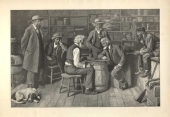The Checker Maven
The World's Most Widely Read Checkers and Draughts Publication
Bob Newell, Editor-in-Chief
Published every Saturday morning in Honolulu, Hawai`i
Noticing missing images? An explanation is here.
Cowan's Coup
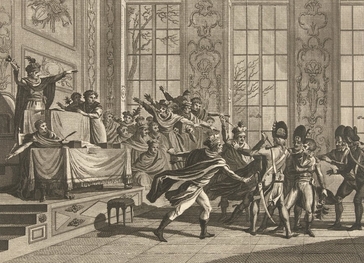
Picryl CC0
When we think of a coup our image is often of one like Napoleon's coup d'etat in November, 1799, as shown above. Certainly, while a coup can be peaceful, alas, it is often anything but. So we've got to be grateful that while les coups can and do take place on the checkerboard, and they may seem rather violent in a checkeristic fashion, nothing is lost except a few pieces of wood or plastic, and even those return alive and well for the next game.
Willie Ryan, in his book Tricks Traps & Shots of the Checkerboard, shows us many a coup. Today, he'll demonstrate one associated with a Mr. Cowan. Let's take a look.
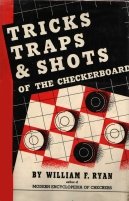
| 9-14 | 7-11 | 2-7 |
| 22-18 | 25-22 | 30-26 |
| 5-9 | 10-15 | 7-14 |
| 24-19 | 19-10 | 26-23 |
| 11-15 | 6-15 | 3-7 |
| 18-11 | 27-24 | 24-20 |
| 8-24 | 16-20 | 7-10---1 |
| 28-19 | 23-19 | 32-28 |
| 4-8 | 20-27 | 1-5 |
| 25-22 | 19-10 | 22-18 |
| 8-11 | 14-23 | 5-9 |
| 22-18 | 26-19 | 28-24 |
| 11—16 | 9-13* | 13—17---A,2 |
| 29-25 | 31-24 | Now you have |
| reproduced the diagram. |

WHITE
White to Play and Draw
W:W24,23,21,20,19,18:B17,14,12,11,10,9.
A---"In 1882, a noted player by the name of M. Cowan, of Whitehaven, England, published the position on the above diagram as a problem. In 1894, Fred S. Hogue, of San Francisco, published the above game, showing how Cowan's "landing" came up in actual play. When Hogue's opponent, playing white, reached the diagrammed setting, he resigned, believing his position hopeless. Suffice it to say that Cowan's Coup may be brought up in play from many different openings. Accordingly, every student of the game must train himself to recognize or anticipate it when it looms on the board."
1---Just about straight "book" play up to this point, where the KingsRow book ends and calls the position dead even---Ed.
2---Pretty much flawless play on both sides. Black appears to have an advantage, but it's an illusion, as the solution will show---Ed.
Will you be overthrown by this problem, or can you carry out the coup? When you've worked out the answers, click on Read More for the revolutionary solution.![]()
Fourth of July Special

Every year we celebrate the 4th of July. As unabashed and unapologetic patriots, it's one of our favorite holidays. America is a great nation, the American people are a great people, and we're proud to honor our country on its birthday.
We won't go quite so far as to say that checkers defines the American character, but as we've said before, there's a democratic side to checkers that appeals to us. Anyone can play and anyone can succeed. It's just a matter of how hard they're willing to work.
America has produced great checkerists such as Marion Tinsley, Asa Long, and many more. But when it comes time to publish an American checker problem, as we're wont to do for the week of 4th of July, we usually turn to all-around great Tom Wiswell. Today is no exception as we present a Wiswell composition that is as elegant as it is difficult. It was originally published under the title The Rainbow.
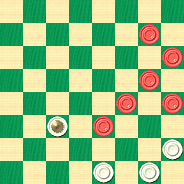
WHITE
White to Play and Draw
W:W32,31,28,K22:B23,20,19,16,12,8.
Mr. Wiswell stated that this problem requires White to make no less than 12 "star" moves (a star move is the only move that will work in a given situation), and little wonder; White is down not one but two pieces. We're setting a tough task here, but we can guarantee that it will be worth the time and effort. Give it your best, and then give it some more, and don't give up. When you're finished, click on Read More to see the solution.![]()
A Little Problem

The young woman in the picture above has a little problem: she's got a square peg and she needs to fit it into a round hole. We suspect that this will not be an easy feat to accomplish, though we surely wish her the best of luck.
Checkers is filled with little problems as well; often they're called "miniatures" and involve just a few pieces per side. They are very often both practical and challenging.
The little problem shown below seems to fit the description perfectly.
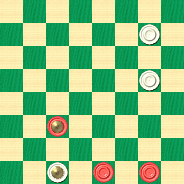
BLACK
Black to Play and Win
B:W25,17,K3:BK11,2,1.
This situation surely arises often over the board, so knowing how to win it could make a real difference. We think it's challenging, but ultimately not all that difficult. Certainly, it's not in the "square peg in a round hole" category.
Can you peg this one just by looking at the diagram? Give it a square try, and then move your mouse 'round to Read More to reveal the solution.![]()
The Spring Chicken

Public Domain
Emma Janvier Smith was a turn-of-the-20th-century vaudeville performer who starred in productions that were famous for that era, including The Moth and the Flame and Miss Innocence; she also took on unique roles such as Girdle in The Spring Chicken. But our research, sadly, turned up no specific evidence that Ms. Janvier Smith played checkers, although we can well imagine her playing a game or two on a night when the theater was dark.
We also don't think she was related to checkerists J.D. Janvier or F. A. Smith, as Janvier was a stage name borrowed from her uncle--- her real surname was Spicer--- and Smith was her husband's name. However, she was certainly a contemporary of both Janvier and Smith. so anything is possible.
But in any case, today's Checker School lesson is about checkers, not vaudeville, though it can surely be argued that at times vaudeville-like situations arise on the checkerboard. Whether that adjective applies to either of the situations below is up to you to decide.
In the first situation, forces are even but White has one man in the "dog hole" on square 28, and the other man definitely lacks mobility.
BLACK
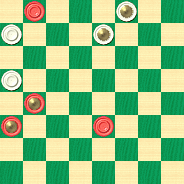
WHITE
White to Play and Draw
W:WK3,5,K7,13:B1,K17,K21,23.
The second situation is quite similar to the first, except that it's Black's move, and he has a third king instead of a second man; as we know, in checkers little things can loom large.
BLACK
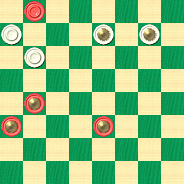
WHITE
Black to Play and Win
B:W5,K7,K8,9:B1,K17,K21,K23.
Can you solve these problems, or will you be the subject of comical failure? Either way, it's no joke that clicking your mouse on Read More will reveal the solutions, detailed notes, no less than four sample games and a supplementary problem.![]()
Clayton's Clipper

Talk about getting clipped! It seems that extreme clipping is the order of the day in the lakeside scene above. We think it may be a bit unusual to go to the lake to get clipped, although in lakeside resorts, it's inevitable that a different sort of "clip joint" is usually to be found.
A player can get clipped at the checkerboard, too, and in just as extreme a fashion. Willie Ryan, in his classic Tricks Traps & Shots of the Checkerboard, illustrates this nicely in his discussion below.

"Sometimes deadly shots exist in situations that appear so innocent that even master minds of the board will fail to detect them. The example shown here is a case in point. I had reached the situation on the diagram in one of my books, but overlooked a trim coup in my analysis. It was spotted by Jeff Clayton, the well-known Oklahoma City expert:
| 11-16 | 18-15 | 5-9---3 |
| 23-18 | 11-18 | 22-18 |
| 16-20 | 22-15 | 3-7 |
| 24-19 | 9-13---1 | 29-25 |
| 7-11---A | 25-22---2 | 7-11---B." |
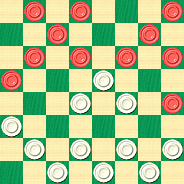
WHITE
White to Play and Win
W:W15,18,19,21,25,26,27,28,30,31,32:B1,2,4,6,8,9,10,11,12,13,20.
A---A very weak move leading to critical play, 10-14 is better.
B---Black walks into a trap with this move. There is a narrow draw here by 1-5---4, 27-23, 9-14, 18-9, 5-14, 25-22, 14-17, 21-14, 10-17, 28-24---5, 20-27, 31-24, 17-21, 23-18, 6-9, 32-27, 8-11, 15-8, 4-11, 27-23, 7-10, 24-20, 2-7, 19-16, 12-19, 23-16, 10-15,16-12, 15-19, 12-8, 7-10, 8-3, 11-16*, 20-11, 10-14, 18-15, 14-18, 15-10, 18-25, 10-6, 25-29, etc. Wm. F. Ryan."
1---8-11 is quite a bit better---Ed.
2---27-23 would have kept the edge---Ed.
3---Very weak; 8-11 would keep things on an even keel---Ed.
4---The computer disagrees and thinks this is still a probable loss. See note 5. Instead, Black should play 12-16! 19-3 10-19 3-10 6-29 27-23 9-14 23-16 29-25 etc. White still has a clear lead and a likely win, but Black's chances are a little better. It's surprising that Willie didn't look at this spectacular shot---Ed.
5---This move appears to be incorrect and gives up the win. 32-27 retains a strong White lead---Ed.
Are you going to get clipped by this problem situation, or are you able to cut it? Try to find the solution, and then slice your mouse over to Read More to see how it's done.![]()
Speeding Into Beulah

June's speed problem is taken from an actual game played on the It's Your Turn Internet site. The winning player in our problem situation uses the screen name Yearof57; his real name is Flavious Burgess and he hails from Beulah, Kentucky. Mr. Burgess says that he plays in a few tournaments around his home state and tries to play in the Majors Division, but at times "has to" play in the Masters Division. We're hardly surprised at that; Mr. Burgess is a very skilled player.
There's no doubt that he spotted the win in today's problem rather quickly, and you probably won't need a lot of time either, so we'll "help you out" by not giving you much! 10 seconds is all that's left on the clock; click on the link below when you're ready to begin.
June Speed Problem (10 seconds; easy)
![]()
Taking A Break

Some of the problems and study material presented in our weekly columns are, to say the least, somewhat challenging for the average player. But we've always tried to a make a point of having something for everyone, so, once again, we're "taking a break" from the really hard stuff and presenting a problem that is interesting, practical, and not so difficult.
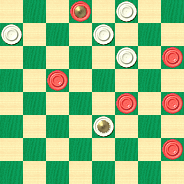
BLACK
Black to Play and Win
B:W30,28,26,22,K10:BK31,21,19,14,13,5.
Black is a man up, but not for long. Still, there is a very nice win on the board. Can you see it? We'd rate this problem as no higher than "intermediate" in difficulty, and we're sure the more experienced players will call it "easy." Whatever it may be, can you solve it? The truly easy thing about it: clicking on Read More will lead you right to the solution.![]()
Temporary Office Closing

Our offices are closed until at least mid-summer; we'll be checking email from time to time but may not be able to respond as quickly as usual to your correspondence. Of course, our Saturday morning publication will continue without interruption, so you can count on a fresh new column every weekend, the same as always. Just look below for our latest article.![]()
Fourth Position

"Fourth Position" as practiced in the art of ballet is obviously very elegant, but appears a little uncomfortable to hold on to for any period of time. The ballerina above carries it out with great grace and skill, but we'll venture a guess that she might be a little tired and sore by the end of class.
Fourth Position, featured today in our ongoing Checker School series, doesn't need to be tiresome; it certainly seems easier to master than, for instance, First Position.
Or is it?
The three variants below show that there may be more here than meets the eye. Subtle changes to the position cause completely different end results. Maybe there's something to this after all!
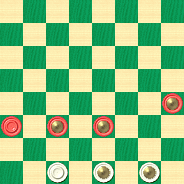
WHITE
Black to Play and Win
B:W30,K31,K32:BK20,21,K22,K23.
BLACK
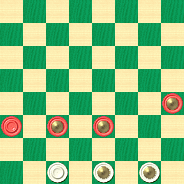
WHITE
White to Play and Draw
W:W30,K31,K32:BK20,21,K22,K23.
BLACK
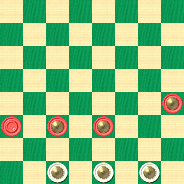
WHITE
Black to Play and Win
B:WK30,K31,K32:BK20,21,K22,K23.
In any event, it's all very practical, as four to three endings of this type come up quite often in cross-board play. Try to work out the solutions and understand why small changes make big differences. Then glide your mouse over to Read More to see the solution, sample games, and detailed explanatory notes.![]()
Priest's Pulverizer

The wicked-looking instrument in the photo above is known as a "Jackson Pulverizer" and when someone is wielding it, perhaps it is best to stand clear.
There are pulverizers in the game of checkers too, as this month's installment from Willie Ryan's Tricks Traps & Shots of the Checkerboard will clearly demonstrate, and they're no less fearsome than the steel variety. Let's see what Willie says about this.
| 10-15 | 23-18 | 8-12 |
| 21-17 | 12-16 | 27-24 |
| 6-10 | 24-20 | 3-8---B |
| 17-13 | 16-19 | 31-27 |
| 1-6 | 25-21---A | 12-16---C |
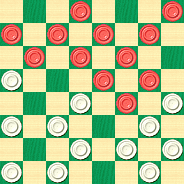
WHITE
White to Play and Win
W:W13,18,20,21,22,24,26,27,28,29,30,32:B2,4,5,6,7,8,9,10,11,15,16,19.

"Now the stage is all set for a ripping cul de sac, which American Champion Matty Priest sprung on James P. Reed in 1878.
A---If white tries 27-24, black goes 10-14, 20-16, 14-23, 24-20, 7-10*, 16-7, 2-11, 31-27, 8-12, 27-18, 19-24, 28-19, 15-24, and white's draw, if any, is problematical.
B---If black presses 10-14, white gets a winning game by 26-23---3.
C---This is where Reed took the wrong road. The following is correct to draw: 9-14, 18-9, 5-14, 22-17, 11-16, 20-11, 7-16, 29-25, 2-7, 24-20, 8-11, 27-23, 15-18, 32-27, 19-24, 28-19, 11-15, 20-2, 15-31, 2-9, 18-27, 9-18, 31-15, 17-14, 10-17, 21-14. James Lees."
3---We're not really sure where Willie was going with this, as the computer definitely thinks this line is drawn. Perhaps over the board it's difficult to play---Ed.
Can you pound your way through this position, or will you get pounded? We think you should give it a smashing good try before clicking your mouse on Read More to see the solution.![]()
The Checker Maven is produced at editorial offices in Honolulu, Hawai`i, as a completely non-commercial public service from which no income is obtained or sought. Original material is Copyright © 2004-2025 Avi Gobbler Publishing. Other material is public domain, AI generated, as attributed, or licensed under CC1, CC2,CC3 or CC4. Information presented on this site is offered as-is, at no cost, and bears no express or implied warranty as to accuracy or usability. You agree that you use such information entirely at your own risk. No liabilities of any kind under any legal theory whatsoever are accepted. The Checker Maven is dedicated to the memory of Mr. Bob Newell, Sr.

